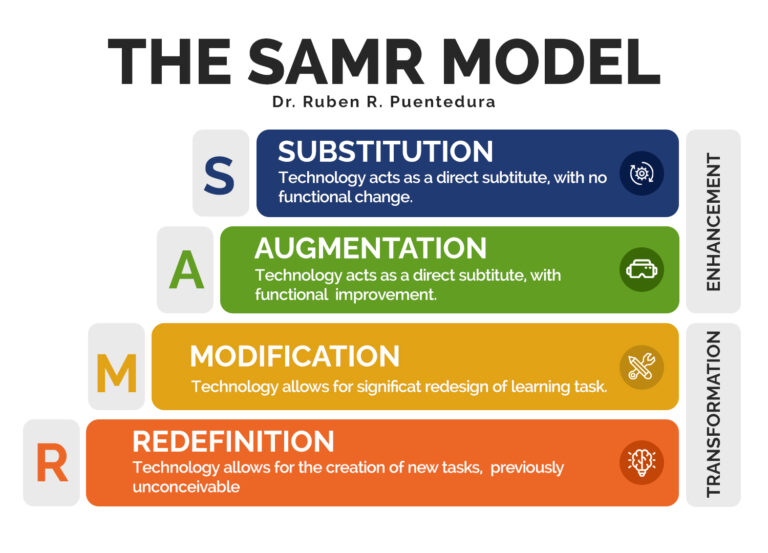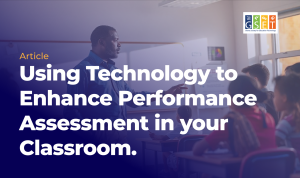
GSET Blogs
The SAMR Models of Technology integration: Practical Cases for your Classroom
Introduction
Integrating technology into education could be challenging even in cases where all external challenges have been mitigated and enough resources like computers, internet connectivity amongst many are at the disposal of the school and teachers. There are numerous frameworks and models that guide teachers to better integrate technology into teaching and learning.
For teachers to effectively integrate technology into education, teachers must have an in-depth understanding of various frameworks and how they can apply them to integrate technology into teaching and learning.
One of the Technology integration frameworks that has served essentially as a planning tool that helps us design better learning experiences for learners and provides pedagogical insight into using technology in the classroom is the SAMR Model.
The SAMR model, developed by Dr. Ruben Puentedura, provides a practical guide for teachers to evaluate how effectively they are using technology in their classrooms. SAMR stands for four levels (Substitution, Augmentation, Modification, and Redefinition.) which are further grouped into two categories (Enhancement and Transformation). It serves as a process for integrating technology, from simply replacing traditional tools to transforming learning tasks in meaningful ways.

In this article, we’ll explore each level of the SAMR model and provide practical examples in Mathematics, Science and English language that teachers can apply in their classrooms.
LEVEL 1 – ENHANCEMENT
Substitution: Replacing Traditional Tools with Digital Technology
At the Substitution level, technology is used as a direct substitute for traditional tools, without changing the functional purpose of the task. While this does make materials more accessible, the learning task remains fundamentally the same.
Example 1: Using an E-Book Instead of a Printed Textbook
In a Reading comprehension class, instead of using a traditional printed textbook, students read the same material from an ebook on their tablets or laptops. The content and task remain the same, but the medium changes from paper to digital.
Example 2: Digital Worksheets
In a math class, a teacher might replace a paper worksheet with a Google Doc or Form that students complete online. The questions and instructions remain the same, but students now type their answers or select right answers by clicking instead of writing them by hand.
While substitution makes materials easier to distribute and access, it doesn’t fundamentally change how students learn.
Augmentation: Improving Traditional Tasks with Technology
At the Augmentation level, technology offers functional improvements that enhance the learning task. The core activity remains the same, but the use of digital tools makes the process more efficient or engaging.
Example 1: Watching videos to understand complex concepts
In a social studies class,teachers can use a video to help students understand the impact of galamsey on our vegetation and water bodies. At the Augmentation stage, technology enhances the learning process but doesn’t change the overall task structure.
LEVEL 2 – TRANSFORMATION
Modification: Redesigning the Learning Task with Technology
Modification represents a significant shift in how technology is used. At this level, technology allows for the redesign of traditional tasks, creating opportunities for deeper engagement and collaboration.
Example 1: Collaborative Group Projects Using Multimedia
Instead of simply writing a report, students can work in groups to create a multimedia presentation using Google Slides or Microsoft PowerPoint. They can integrate videos, images, and links to external resources, and collaborate in real-time from different locations. This shifts the task from being a simple report to a more dynamic, multimedia experience.
Example 2: Interactive Science Labs
In a science class, students conduct virtual experiments using online simulations (like PhET Interactive Simulations). Rather than just reading about a concept or watching a demonstration, students actively manipulate variables in a virtual lab setting and observe the outcomes. This kind of task redesign helps students engage with content in a way that wouldn’t be possible with traditional tools.
Redefinition: Creating New Tasks that are Previously Inconceivable
At the Redefinition level, technology enables entirely new learning tasks that were not possible without digital tools. This level transforms the learning experience by allowing students to engage in activities that foster creativity, critical thinking, and global collaboration.
Example 1: Global Collaboration Through Virtual Classrooms
Students in a social studies class collaborate with a class in another country through video conferencing tools like Zoom or Microsoft Teams. Together, they work on a research project comparing their cultures and create a joint presentation or video. This type of cross-cultural collaboration would not be possible without technology, and it allows students to develop global awareness and communication skills.
Example 2: Student-Created Podcasts or Blogs
Instead of writing traditional essays, students in a history class create podcasts or blogs where they interview experts, analyze historical events, and publish their work for a global audience. This transforms the assignment from a private academic exercise into a real-world project that engages with a broader community. Students develop a sense of ownership over their work, as well as digital literacy skills.
Practical Steps for Implementing the SAMR Model
Integrating the SAMR model into your teaching practice requires intentionality. Here are a few practical steps to get started:
- Start with The first level of enhancement (Substitution and Augmentation):
Don’t feel pressured to jump straight into modification or redefinition. Begin by identifying tasks where technology can easily substitute or augment traditional tools, such as using digital quizzes, typing assignments online and reading ebooks.
Only move to the transformation level when you and your student are comfortable with technology for enhancement.
- Move Toward Transformation: As you become more comfortable with technology, look for opportunities to modify or redefine tasks. Think about how technology can enable more interactive, collaborative, or creative learning experiences. Introducing more project based learning at this stage that requires the use of technology.
- Align with Learning Objectives: Always ensure that the use of technology aligns with your learning goals. Technology should enhance student understanding, not just be an add-on. Ask yourself: How does this tool help students engage more deeply with the content?
Also make sure you plan your lesson before looking at technologies that can enhance or transform the learning experience.
- Foster Digital Literacy: Encourage students to use technology creatively and responsibly. As you move up the SAMR model, students should take ownership of their learning and develop digital literacy skills that will serve them in the future.
- Reflect and Adapt: Continuously reflect on how well your technology integration is working. Ask for student feedback, observe their engagement, and make adjustments as needed.
In a nutshell, the SAMR model helps teachers think about how to integrate technology effectively in the classroom. Whether you’re just starting with substitution or aiming to redefine tasks, the key is to use technology in ways that make learning more engaging and meaningful. With SAMR, you can ensure that technology isn’t just a gimmick but a powerful tool that enhances teaching and prepares students for the future.
More Posts


The Gaps In The Ongoing Implementation Of The Standard-Based Curriculum

Beyond The Screen: Rethinking EdTech as a Timeless Learning Continuum

Managing Difficult Questions during Lessons- The Place of Digital Learning for Teachers


2 thoughts on “The SAMR Models of Technology integration: Practical Cases for your Classroom”
Well designed technology tool that will go a long way to improve quality of teaching and learning experiences
I’ve learned a great deal on SAMR model. I’m a level 400 student of University of Ghana and reading multimedia tools in education . This is very helpful for me since I will be transitioning into the field of work very soon.